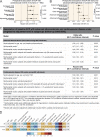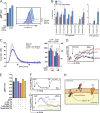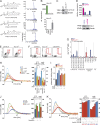Enzymatic lipid oxidation by eosinophils propagates coagulation, hemostasis, and thrombotic disease
- PMID: 28566277
- PMCID: PMC5502424
- DOI: 10.1084/jem.20161070
Enzymatic lipid oxidation by eosinophils propagates coagulation, hemostasis, and thrombotic disease
Erratum in
-
Correction: Enzymatic lipid oxidation by eosinophils propagates coagulation, hemostasis, and thrombotic disease.J Exp Med. 2018 Mar 5;215(3):1003. doi: 10.1084/jem.2016107002142018c. Epub 2018 Feb 20. J Exp Med. 2018. PMID: 29463570 Free PMC article. No abstract available.
Abstract
Blood coagulation is essential for physiological hemostasis but simultaneously contributes to thrombotic disease. However, molecular and cellular events controlling initiation and propagation of coagulation are still incompletely understood. In this study, we demonstrate an unexpected role of eosinophils during plasmatic coagulation, hemostasis, and thrombosis. Using a large-scale epidemiological approach, we identified eosinophil cationic protein as an independent and predictive risk factor for thrombotic events in humans. Concurrent experiments showed that eosinophils contributed to intravascular thrombosis by exhibiting a strong endogenous thrombin-generation capacity that relied on the enzymatic generation and active provision of a procoagulant phospholipid surface enriched in 12/15-lipoxygenase-derived hydroxyeicosatetraenoic acid-phosphatidylethanolamines. Our findings reveal a previously unrecognized role of eosinophils and enzymatic lipid oxidation as regulatory elements that facilitate both hemostasis and thrombosis in response to vascular injury, thus identifying promising new targets for the treatment of thrombotic disease.
© 2017 Uderhardt et al.
Figures






Similar articles
-
15-Lipoxygenase and 15-hydroxyeicosatetraenoic acid regulate intravascular thrombosis in pulmonary hypertension.Am J Physiol Lung Cell Mol Physiol. 2015 Sep 1;309(5):L449-62. doi: 10.1152/ajplung.00004.2015. Epub 2015 Jun 19. Am J Physiol Lung Cell Mol Physiol. 2015. PMID: 26092993
-
Epigenetic Histone Modifications Involved in Profibrotic Gene Regulation by 12/15-Lipoxygenase and Its Oxidized Lipid Products in Diabetic Nephropathy.Antioxid Redox Signal. 2016 Mar 1;24(7):361-75. doi: 10.1089/ars.2015.6372. Epub 2015 Nov 30. Antioxid Redox Signal. 2016. PMID: 26492974 Free PMC article.
-
Key role of 15-LO/15-HETE in angiogenesis and functional recovery in later stages of post-stroke mice.Sci Rep. 2017 Apr 24;7:46698. doi: 10.1038/srep46698. Sci Rep. 2017. PMID: 28436420 Free PMC article.
-
Blood coagulation: hemostasis and thrombin regulation.Anesth Analg. 2009 May;108(5):1433-46. doi: 10.1213/ane.0b013e31819bcc9c. Anesth Analg. 2009. PMID: 19372317 Review.
-
12-lipoxygenase: a potential target for novel anti-platelet therapeutics.Cardiovasc Hematol Agents Med Chem. 2011 Jul 1;9(3):154-64. doi: 10.2174/187152511797037619. Cardiovasc Hematol Agents Med Chem. 2011. PMID: 21838667 Free PMC article. Review.
Cited by
-
Interplay between inflammation and thrombosis in cardiovascular pathology.Nat Rev Cardiol. 2021 Sep;18(9):666-682. doi: 10.1038/s41569-021-00552-1. Epub 2021 May 6. Nat Rev Cardiol. 2021. PMID: 33958774 Free PMC article. Review.
-
Resolution of Crohn's disease.Semin Immunopathol. 2019 Nov;41(6):737-746. doi: 10.1007/s00281-019-00756-1. Epub 2019 Sep 24. Semin Immunopathol. 2019. PMID: 31552470 Review.
-
Reactive Oxygen Species in Venous Thrombosis.Int J Mol Sci. 2020 Mar 11;21(6):1918. doi: 10.3390/ijms21061918. Int J Mol Sci. 2020. PMID: 32168908 Free PMC article. Review.
-
Eosinophilic Granulomatosis With Polyangiitis: Dissecting the Pathophysiology.Front Med (Lausanne). 2021 Feb 24;8:627776. doi: 10.3389/fmed.2021.627776. eCollection 2021. Front Med (Lausanne). 2021. PMID: 33718405 Free PMC article. Review.
-
Identification of Genetic Modifiers of TDP-43: Inflammatory Activation of Astrocytes for Neuroinflammation.Cells. 2021 Mar 18;10(3):676. doi: 10.3390/cells10030676. Cells. 2021. PMID: 33803845 Free PMC article.
References
-
- Assarsson E., Lundberg M., Holmquist G., Björkesten J., Thorsen S.B., Ekman D., Eriksson A., Rennel Dickens E., Ohlsson S., Edfeldt G., et al. . 2014. Homogenous 96-plex PEA immunoassay exhibiting high sensitivity, specificity, and excellent scalability. PLoS One. 9:e95192 10.1371/journal.pone.0095192 - DOI - PMC - PubMed
-
- Clark S.R., Thomas C.P., Hammond V.J., Aldrovandi M., Wilkinson G.W., Hart K.W., Murphy R.C., Collins P.W., and O’Donnell V.B.. 2013. Characterization of platelet aminophospholipid externalization reveals fatty acids as molecular determinants that regulate coagulation. Proc. Natl. Acad. Sci. USA. 110:5875–5880. 10.1073/pnas.1222419110 - DOI - PMC - PubMed
MeSH terms
Substances
Grants and funding
LinkOut - more resources
Full Text Sources
Other Literature Sources
Medical
Molecular Biology Databases

